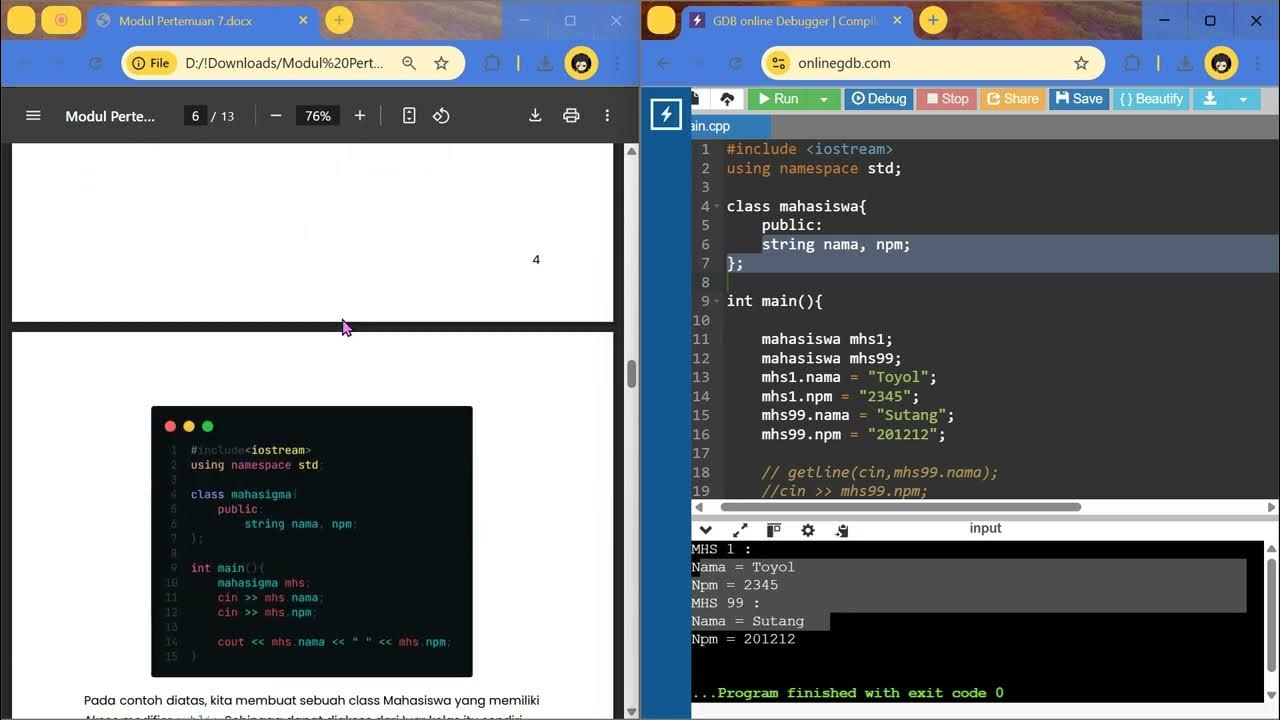Mengenal Array dan Struct Dalam Algoritma Struktur Data
Summary
TLDRThis video explains the importance of arrays and structs in programming, focusing on their use in C. It introduces arrays as a structured data type that can store multiple values of the same type, highlighting their efficiency and indexing system. The video also compares arrays with structs, which can store different data types under a single name. It discusses the key differences, use cases, and benefits of both data structures, offering practical examples and explaining the types of arrays, such as one-dimensional and two-dimensional arrays. The video concludes by emphasizing the significance of understanding arrays and structs in programming.
Takeaways
- 😀 Arrays are data structures that store multiple values of the same data type under one variable name, improving efficiency in managing large sets of data.
- 😀 An array's elements are indexed, typically starting from 0, allowing random access to any element in constant time.
- 😀 Arrays come in various dimensions: 1D arrays store a simple list, while 2D arrays store data in rows and columns, similar to a table.
- 😀 One-dimensional arrays (1D) are commonly used to store data like lists of names, ages, or other related information.
- 😀 Two-dimensional arrays (2D) are useful for storing data in a matrix format, such as a table with rows and columns for more complex data.
- 😀 Arrays help avoid redundancy in variable declarations, allowing efficient use of memory by storing multiple values in contiguous memory locations.
- 😀 A struct (or record) is a more complex data structure that stores variables of different types together under a single name, making it useful for grouping related data.
- 😀 Unlike arrays, structs allow for storing heterogeneous data, meaning elements of different types can be grouped together, like combining a person's name and age in one unit.
- 😀 The key difference between arrays and structs is that arrays store elements of the same data type, whereas structs can store different data types.
- 😀 Structs can be accessed using the names of their variables, while array elements are accessed using numerical indices.
- 😀 Both arrays and structs are essential in programming, but their usage depends on the type of data needed: arrays for similar types and structs for varied types of related data.
Q & A
What is an array in programming?
-An array is a data structure that allows you to store multiple values of the same data type under a single variable name, with each value being accessed by an index.
Why is it important to understand arrays in programming?
-Understanding arrays is crucial because they are foundational for creating efficient programs, enabling storage and access to multiple values using a single variable, which is more efficient than creating multiple individual variables.
How does the concept of an array relate to real-world examples?
-An array can be likened to a shoe rack with many lockers, where each locker (index) can store a single pair of shoes (data). Just like how each locker has an index to access it, arrays use indexes to access data.
What are the advantages of using arrays in programming?
-Arrays allow for efficient storage and management of multiple values of the same type. They enable quick data access using an index and optimize memory usage by storing elements in contiguous memory locations.
What is the main limitation of using arrays?
-The main limitation of arrays is that they can only store elements of the same data type. This can be restrictive when trying to store heterogeneous types of data within the same structure.
How do 1-dimensional arrays differ from 2-dimensional arrays?
-A 1-dimensional array is a simple list of values stored in a single row, whereas a 2-dimensional array is like a table with rows and columns, allowing you to store data in a matrix format.
How do you access elements in a 1-dimensional array?
-To access an element in a 1-dimensional array, you use the array's name followed by the index of the desired element (e.g., array[2]). The index starts from 0.
What is the difference between arrays and structures (structs)?
-Arrays can only store elements of the same data type, whereas structs (structures) can store elements of different data types. Structs allow you to group related data items of varying types together under one name.
Can you store an array within a struct? If so, how?
-Yes, you can store an array within a struct. This is done by defining an array as one of the elements within the struct definition, allowing the struct to hold both different data types and arrays.
How do you declare and use a struct in C programming?
-In C, you declare a struct by defining its type and giving it a name. Then, inside the struct, you define variables of different data types. To use the struct, you create an instance of it and access the members using dot notation (e.g., structInstance.member).
Outlines

This section is available to paid users only. Please upgrade to access this part.
Upgrade NowMindmap

This section is available to paid users only. Please upgrade to access this part.
Upgrade NowKeywords

This section is available to paid users only. Please upgrade to access this part.
Upgrade NowHighlights

This section is available to paid users only. Please upgrade to access this part.
Upgrade NowTranscripts

This section is available to paid users only. Please upgrade to access this part.
Upgrade NowBrowse More Related Video
5.0 / 5 (0 votes)





